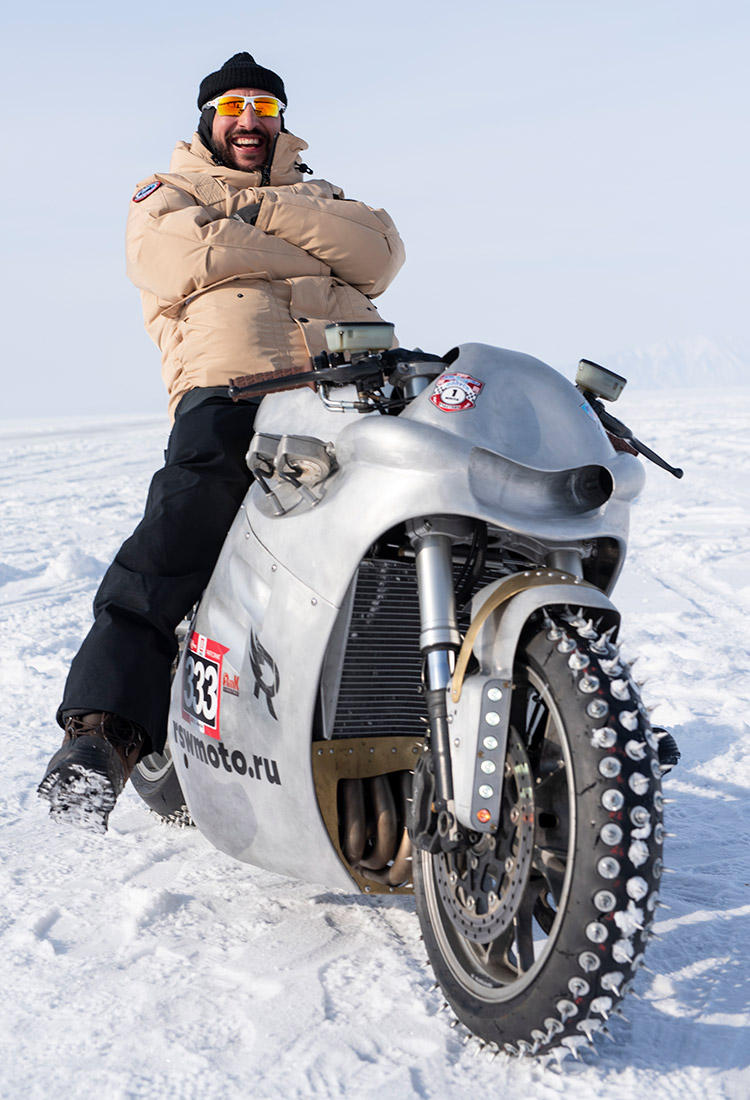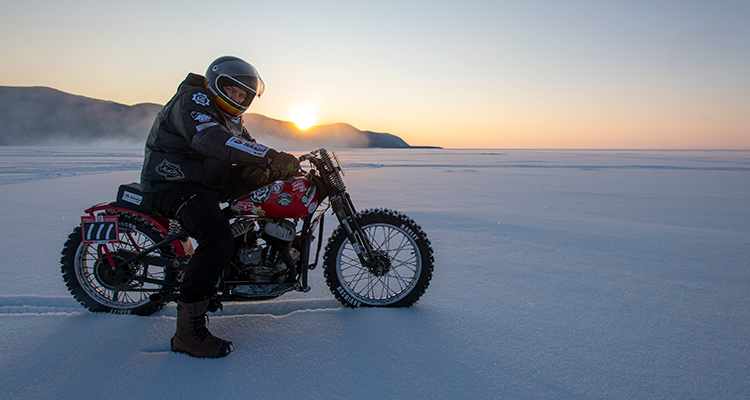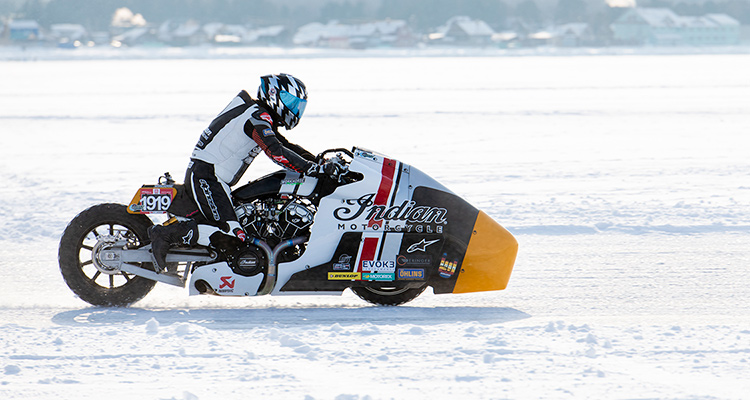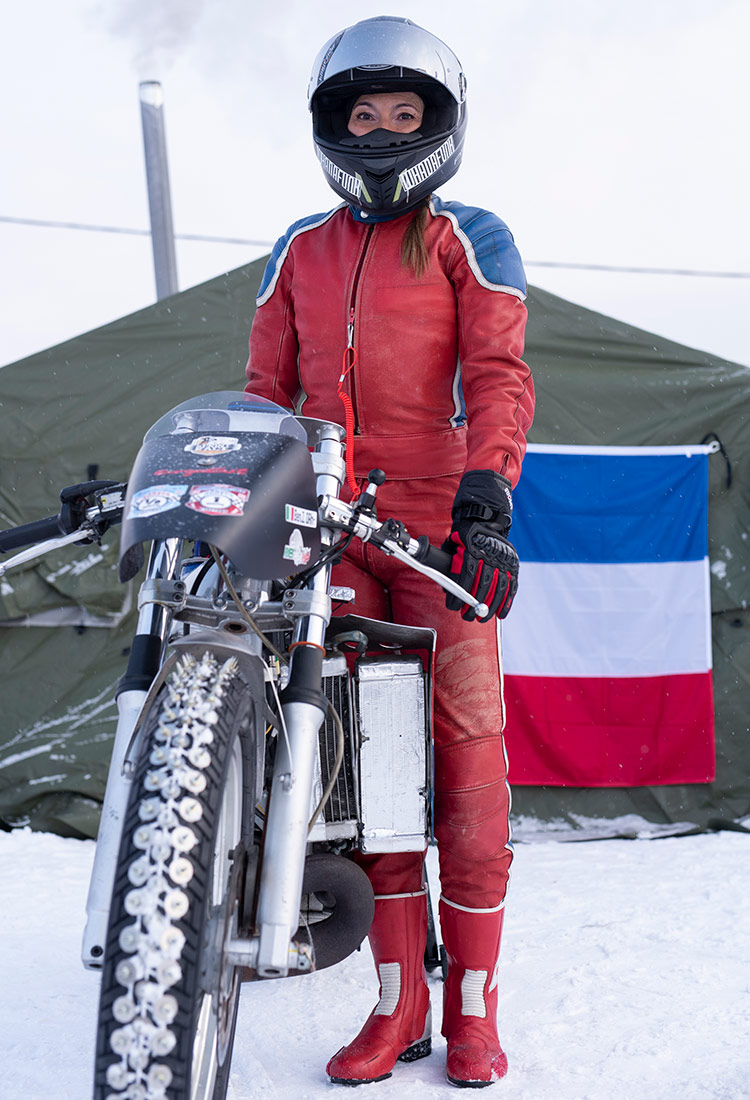Main Feature
The Baikal Mile
Siberia’s Magical Motorcycle Scene
By Michael Lichter
When Dmitry Khitrov invited me to visit Siberia to photograph the Baikal Mile Ice Speed Festival, I immediately replied, “Yes.”
That is my standard answer to any invitation with the possibility of adventure, especially when motorcycles are involved. Plus, this request had the added distinction of the “unknown,” which upped my curiosity a notch.
The brainchild of Sergey Maltsev, Khitrov’s business partner, the event was first held in 2019 on meter-thick ice in the middle of Lake Baikal, widely accepted as the deepest lake in the world.
Doesn’t that sound remote?
“Siberia” conjures up different images, but most probably agree that it is very big and very cold. My wife, Catherine, who didn’t have heat in her childhood home in Ireland, would simply say, “I’m off to Siberia.”
I was nervous. Siberia in February? How would my cameras function in that kind of cold? How would I function in that kind of cold?
Preparing for the trip, I learned that the coldest temperature recorded in Siberia (and in the Northern Hemisphere) was minus 90 in the town of Oymyakon.
I freaked out.
To reach Siberia, my son Sean and I recorded 19 hours, not counting layovers and ground transport, on three aircraft, the final leg an overnight flight from Moscow.
I prepared well, packing multiple down layers, hand/foot warmers and arctic-rated mittens and boots—everything I imagined would be needed. Unfortunately, my suitcase was inaccessible in the car that took us from Ulan-Ude, a city of more 400,000, to the village of Maksimikha, which was hosting the event.
What normally would be a three-hour drive took all day. We stopped in Ulan-Ude’s main square, with its giant Lenin statue, for a Lunar New Year celebration. We also visited a Buddhist Datsan.
The sights were worth the extra time, but when we arrived at Lake Baikal, the temperature had dropped to minus 6 degrees. I was missing my thermals and boots, especially taking photos on the ice in my travel sandals. At least this was the coldest temperature we would experience for the remainder of the trip.
The drive—indeed, the lake itself—emphasized the sheer size of Siberia, which spans 11 time zones and accounts for nearly nine percent of the Earth’s surface. Ian Frazier, who wrote the book, “Travels in Siberia,” said, “Siberia is so big, it’s almost more an idea than a place.”
Living in the western U.S., I know something about size and space, but this was something else. If you could drive all the way around the lake (roads are sparse on the northern end), you would take in roughly 1,300 miles of coastline.
Accompanied by French custom-bike builder Bertrand Dubet and expert mechanic Simon Pitelet, we arrived at the hotel in Maksimikha at dusk. Khitrov and Maltsev whisked us onto the lake for a breathtaking sunset, as well as a glimpse of the growing “Speed Village.”
We woke Tuesday to sunshine, as more people and vehicles arrived. The speed tests and qualifying didn’t start until Thursday, but there was much to do and see.
You might think Khitrov and Maltsev would repeat what they did in 2019, but the first edition was a test, a gathering of likeminded petrolheads, who met on the ice to see what they could do with their bikes and cars. Most attendees didn’t know each other before the event. But together—sharing knowledge and tools, racing and drinking vodka—they created something special. The Baikal Mile Ice Speed Festival had grown legs.
For 2020, Khitrov and Maltsev envisioned a fun, safe event. Baikal is believed to be the purest lake in the world, so not even a drop of oil could remain. Timing and record keeping were on the to-do list but fell below “fun,” since, really, everybody just wanted to have a good time.
The village has one winterized hotel, so most attendees booked stays in nearby towns. Pre-event entries were limited to 114 vehicles. Spectators? One of the partners is the tourist board for the region. They knew many would make the three-hour drive from Ulan-Ude on Saturday for the main event.
To prepare for a crowd, carpenters, electricians and other workers set up a paddock on the ice with heated yurts where bikes could be tuned, larger tents for catering and media, grandstands and a stage for opening ceremonies. Fencing separated the race course from public areas.
Meanwhile, two mile-long tracks—one for two wheels, the other for four—were groomed every moment of the day to ensure they would be suitable for competition.

Racers kept busy with last-minute tuning. Hot rods and bikes in crates were pulled off semis. Dubet’s Salt & Copper Aprilia RSV4 was moved into the hotel’s basement garage, where he and Pitelet refitted parts removed to ship the bike from France.
Two more bikes arrived from Europe, one of which was Bene Zaccherini’s 1999 Husqvarna WR 360. Zaccherini had on-point help from a French ice-stud manufacturer and mechanic Raphael Bonifay.
Brice Hennebert, of Belgium’s Workhorse Speed Shop, brought his Indian Scout Bobber, “Appaloosa,” with Sebastien Lorentz of Luckycat Garage at the controls.
There was a buzz in the air from all the activity. On Thursday, after the machines had been inspected, a quarter-mile track was opened for everyone to get a feel for the ice. This was a required run; everyone had to qualify before they could move to the mile.
The machinery was incredible. In addition to motorcycles, I saw minibikes, monowheels, sidecars, trikes, quads, go-karts, a number of air boats, a Scania truck and even a Bentley Continental rolling on giant tank tracks. The only vehicle that wasn’t required to prequalify was a Mil Mi-8 helicopter. Everyone was in great spirits, and spirits were liberally shared.
As predicted, Saturday was big. Between racers, crew members and spectators, about a thousand people flew in, mostly from Moscow, 3,700 miles away. Authorities believed locals numbered close to 5,000. Racers were introduced individually, all to big cheers, after which they paraded through the crowd for photos. Buriyatian dancers and musicians in regional dress provided additional color and flavor. This part of Lake Baikal is just north of the Mongolian border, so culture lives deep within these people.
 Some took the event more seriously than others. Alexander Mishkinis, for example, posted the highest speed, 163 mph, on his BMW S 1000 RR. A group from Moscow Polytechnic University built an electric race bike piloted by Mikhail Mikhin that topped 130 mph. Speeds were clocked before the end of the “mile,” which actually measured 1,642 meters [1.02 miles], the depth of the lake.
Some took the event more seriously than others. Alexander Mishkinis, for example, posted the highest speed, 163 mph, on his BMW S 1000 RR. A group from Moscow Polytechnic University built an electric race bike piloted by Mikhail Mikhin that topped 130 mph. Speeds were clocked before the end of the “mile,” which actually measured 1,642 meters [1.02 miles], the depth of the lake.
The custom builders were led by Yaroslav Tatarinov’s 1,350cc Kawasaki, with its handcrafted aluminum bodywork, and Dima Golubchikov on a speedway-inspired, twin-engine Jawa. Most participants wanted to go a little faster each pass. The rest of us were just happy to be there.
When the racing was done, the ice was transformed into a disco. The Belgian delegation set up on a turntable on stage, covering themselves with plastic to keep the vinyl dry from falling snow. Lights illuminated the sky, and the air sparkled like a fairytale. We danced into the night.
Ultimately, Sean and I slipped away with our French and Italian friends to drill a hole in the ice, into which we poured a shot of vodka for a “Baikal Kiss.”
What a great way to say, “Goodbye.”






